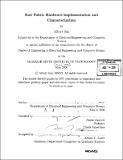Raw fabric hardware implementation and characterization
Author(s)
Sun, Albert (Albert G.)
DownloadFull printable version (4.707Mb)
Other Contributors
Massachusetts Institute of Technology. Dept. of Electrical Engineering and Computer Science.
Advisor
Anant Agarwal.
Terms of use
Metadata
Show full item recordAbstract
The Raw architecture is scalable, improving performance not by pushing the limits of clock frequency, but by spreading computation across numerous simple, replicated tiles. The first Raw processors fabricated have 16 RISC processor tiles that share the workload. The Raw Fabric system extends Raw's scalability by weaving together multiple 16-tile Raw processors. The Raw Fabric is a modular and scalable system comprised of two board types: one to house 4 Raw processors (Processor board) and one to handle communications (I/O board). The design is modular because it breaks down the system into smaller parts, and it is scalable because these modules may be combined to create large Fabrics. The ultimate goal is to produce a Raw Fabric with 16 Processor boards (equivalently, 64 Raw processors or 1024 tiles), though the current largest Fabric system includes one Processor board and 3 I/O boards. This thesis walks through the important design and implementation challenges and documents how they were solved. The most basic challenge faced was to design a system flexible enough to accommodate a variety of Fabric sizes. (cont.) Next, the distribution of vital signals such as power and clock provides a problem unique to the Fabric system because of the possible size of the final product. Finally, the astounding number of signal wires running between boards presents a unique challenge in finding parts and designing the mechanical aspects. The intent of this thesis is to provide the reader with an idea of the considerations necessary for designing and implementing a system of this magnitude and level of flexibility.
Description
Thesis (M. Eng.)--Massachusetts Institute of Technology, Dept. of Electrical Engineering and Computer Science, 2006. Includes bibliographical references (p. 109-110).
Date issued
2006Department
Massachusetts Institute of Technology. Department of Electrical Engineering and Computer SciencePublisher
Massachusetts Institute of Technology
Keywords
Electrical Engineering and Computer Science.